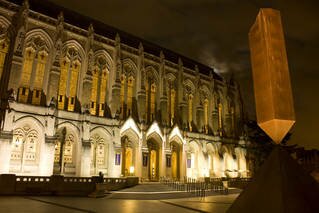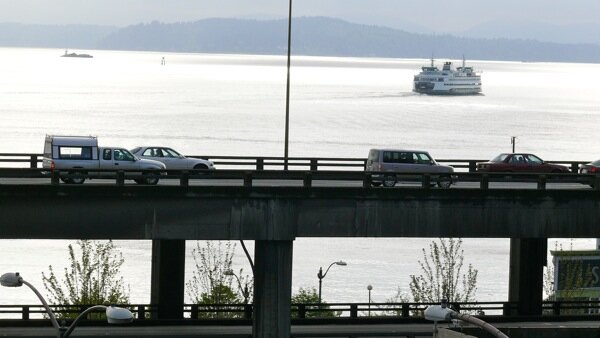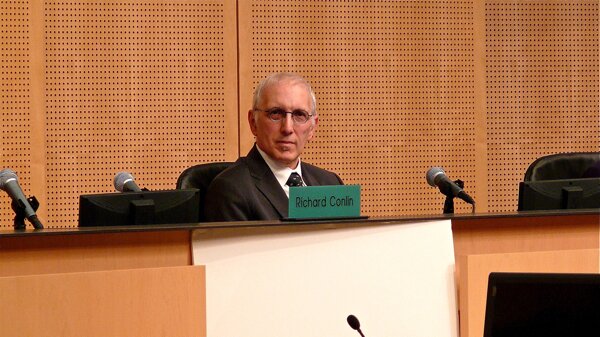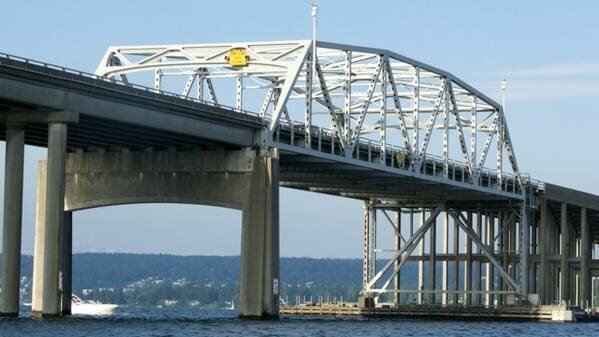 Our Flickr pool's Great Beyond gives us "Broken Obelisk at night"
Our Flickr pool's Great Beyond gives us "Broken Obelisk at night"
Ladies and gentlemen, we are taking on water, and in order to survive, some passengers need to be thrown overboard. The good news is that first class and corporate passengers are exempt. Those passengers are welcome to visit our new and improved buffet and to enjoy dancing well into the night.
This announcement also bears a striking resemblance to the weak-kneed announcement regarding the tax "deal" issued this week by the president, now living as a hostage in the White House to cynicism and greed. Just like the middle and lower classes of America.
Here at the University of Washington, this announcement was both expected and anticipated. We've been watching the water rise for a few years now. What this dispatch addresses are the various reactions across campus to the announcement.
- A dean, in an effort to sooth anxiety, sent out an email that said we should go into the holiday break in denial and just enjoy ourselves.
- The interim president, in an article in the Tacoma News Tribune this week, naively insisted that the necessity to accept "alternative funding" (read: corporatization/privatization) would never change the identity and mission of the UW.
- The faculty senate continues to meet, consternate, debate, proclaim, and declare in the cold ocean of irrelevance, since the idea of shared governance at UW is nothing more than a condescending platitude.
- Units and departments frantically rearrange deck chairs, even as the deck chairs themselves are becoming scarce.
- Students who face double digit increases in tuition, larger classes and reduced course offerings continue to Facebook and YouTube their lives away in blissful apathy, gently rocked by the waves of inevitability....
 Seattle-based Women’s Funding Alliance (WFA), the leading foundation in Washington state investing in and advocating for women and girls, is confronting the issue of local sex trafficking from numerous angles with the aim of attacking the root cause of the problem through education, awareness and funding.
Seattle-based Women’s Funding Alliance (WFA), the leading foundation in Washington state investing in and advocating for women and girls, is confronting the issue of local sex trafficking from numerous angles with the aim of attacking the root cause of the problem through education, awareness and funding.
WFA will host a Town Hall forum on January 20, 2011, called “In Our Own Backyard: A Closer Look at the Sex Trafficking of Local Girls.” The event is a public forum to discuss the issue of sex trafficking, how the internet is worsening the problem, what’s being done about it, and how we can make a difference right here in Seattle to support young trafficking survivors, increase the prosecution of traffickers and predators, and curb the demand.
That event is hosted in collaboration with Seattle City Council, Seattle Human Services Department, YouthCare and Women’s Funding Network.
In January 2010, WFA approved a special, one-time grant for a three-year pilot project of the Seattle Human Services Department (SHSD) called The Bridge Program, a residential recovery program designed to help girls who have been victimized through child sexual exploitation (prostitution). (See the Seattle Times article on the program.)
WFA was able to provide funding for the program during a critical period when funds had been cut and the project’s future was uncertain....
 The Viaduct will outlive us all.
The Viaduct will outlive us all.
You know that phrase, "money quote"? This time it's literal:
"Both teams, and maybe the two teams that dropped out, expressed concern the [state's cost target] is too low. They couldn't figure out how to bid the project at that amount or lower," Dick Page told the Seattle Times, explaining WSDOT's decision to spend down its $415 million cash reserve by $230 million in concessions to the two bidding teams.
(Page is district leader for HNTB, the engineering part of Seattle Tunnel Partners, which also includes Dragados-USA; the Seattle Tunneling Group is a consortium of S A Healy and FCC Construccion, SA, with design by Parsons Transportation Group and Halcrow.)
Keep in mind that, as TunnelTalk reports, "Specifications within the bid documents are minimal. Much of the means, methods and risk mitigation measures are left to the expertise and preferences of the pre-qualified design-build bidding teams."
Projected tunnel costs have already increased by $60 million, so with this latest news, WSDOT's Cost Estimate Valuation Process has been on the low side by around $300 million on a $2.1 billion project.
Yes, the contingency and risk fund was included in the original estimate, but what we're seeing is that contingency and risk have eaten up half that fund a year before a single clod of earth has been moved. That's not a good sign; what's also not a good sign is that you can't seem to find a single tunnel proponent who is bothered by it.
They should be, because the merits of the project aside, the deep-bore tunnel could see a funding death by a thousand cuts. The state has resolutely capped its contribution to the entire $4.24-billion project at $2.8 billion (leading to a contentious debate over whether Seattle is responsible for any overages). Tolling will be needed to make up part of the funding gap (a tricky prospect, since the higher the tolls are set, the fewer people will use the tunnel).
And the state may have already bitten off more than it can chew. In February, the state's gas tax revenue was down $168 million for the 2009-2011 biennium. The state's Office of Financial Management has updated that number, and the decline has continued. Some $1.8 billion of tunnel funding is supposed to come from gas tax increases passed in 2003 and 2005, but over the entire 16-year forecast horizon for gas tax revenues, the forecast for September 2010 is down almost one percent ($180 million) from the June 2010 forecast. All transportation revenues are off almost $1 billion over that period....
 City Councilmember Nick Licata
City Councilmember Nick Licata
I can already see Nick Licata's Christmas card to Mayor McGinn: "Thanks for making me look middle-of-the-road." The City Council's Licata has long been--years before President Obama's election--Seattle's "socialist" in city government, often ending up on the wrong end of the teeter-totter from everyone else on the Council.
With McGinn assuming the loose lefty cannon mantle, Licata has been free to act as the voice of reason. Today, he's brokered a compromise to quell the contretemps arising from the funding of MOHAI's move to the Lake Union Armory. (The details are spelled out in his Urban Politics newsletter, which will be up shortly.)
With statesmanlike restraint, Licata chose to focus on the more proximate needs of the two parties at odds: Mayor McGinn needs to find cash to balance the budget, and MOHAI needs all the help it can get to survive its move. What Licata rather cunningly realized is that the two cash crunches don't coincide in time. His compromise means the city will still pay MOHAI the agreed upon $7 million, but not during the next budget year.
Restructuring the release of the $40 million that MOHAI will receive from the State can achieve these two objectives. The City will retain $8.5 million during 2011 and 2012 and then pass that amount onto MOHAI after we receive our share of the land proceeds in 2013 or later. The result is that we have real cash to spend on one-time needs, like summer youth employment, library collections, and food banks that we otherwise would not have....
(more)
Working my way through the draft of Washington Transportation Plan 2030, I keep coming across what looks like the future arriving today. Unfortunately, it's the future in which the state is broke, but still wants to spend billions on more roads.
"It is noteworthy that approximately 64% of current transportation funding is dependent on how much fuel cars and trucks consume," goes the report, noting at the outset that "the existing 2007-2026 WTP identifies a need to invest more than $67 billion over 20 years (2005 dollars), most of which is unfunded."
With the spike in fuel prices previously and now the recession, people have been driving less, and state revenue from the gas tax has dropped to "E" when it comes to new projects.
Today a Seattle Times headline gives you Exhibit A: "520 bridge shortfall: more tolls, taxes ahead." Even with peak driving time tolls of $3.50 each way, 520 replacement monies fall short. "The forecasts errantly assumed growth in gasoline use, which instead has gone nearly flat," says Mike Lindblom.
It's long been suspected that I-90 will need to be tolled in tandem with 520, which Seattle Senator Ed Murray is in favor of. But no one is jumping on the Coalition for a Sustainable SR 520's funding bandwagon: Their idea is to institute tolls now and a) raise money in advance while b) confirming the effects of $7 daily roundtrip tolls on traffic demand.
The same strategy could be put into effect on SR 99 (aka the Viaduct), since the state plans to toll the deep-bore tunnel as well. But so far the state seems shy about raising money in ways that might affect the rationale for spending billions on new lanes....
The tunnel's southern approach, or, "Acres of Asphalt"
Yesterday City Council President Richard Conlin published an op-ed at Publicola, "State Overrun Language Serves Only to Alarm and Divide Seattleites." Mega dittos! said the Council's Tim Burgess. Apparently the two are unfazed by the prospect of bankruptcy of any kind, including intellectual.
At this point, the two have sailed deep into Glenn Beck territory, in terms of purely opportunistic argument. Forget what Conlin said before--it's different when you really want the shiny new toy.
The groupthink boosterism the two display is probably the most chilling thing to witness, since it's so pernicious to thoughtful assessment in general. When Conlin and Burgess try to characterize the replacement of the Alaskan Way Viaduct as a choice between a deep-bore tunnel or "bicycles," they sink to an embarrassing elementary-school level of disparagement.
Both men's thinking is so riddled with biased "evidence gathering" that it's hard to determine where to start in responding. There's little point in assembling a tedious list of corrections. In the long run, it doesn't matter what either of these men are "for," as regards the project. It's a state route, and the State is driving. It can only matter how well they look after Seattle's interests--and they seem to deaf to a good deal of the clamor around those.
As for "alarm" and "division," there has been no demonstrated majority in favor of a deep-bore tunnel; there is only the failure of the cut-and-cover tunnel option on a public ballot, which is neither here nor there unless you conclude that cost was a decisive factor in that tunnel's rejection. (An astute political leader might steal Mayor McGinn's "obstructionist" wind by reclaiming the fiscal conservative role, but it appears that, deep down, local leadership believe fiscal conservatism and the deep-bore tunnel to be antithetical.)...
If you're not a working artist in King County, or some sort of moneyed arts patron, you may well have no idea what 4Culture is. But if you make art in or around Seattle, or work on cultural preservation projects, you definitely do, because 4Culture forms a crucial component of the funding process for local artists, cultural centers, and arts organizations, and currently, they're under threat.
Here's how it works--the state levies a 6.5-percent tax on hotel and lodging. Back in the 1970s, when King County was looking for ways to fund building the Kingdome, the state agreed to give the county a 2-percent credit against the tax collected in King County to service the debt. Over the years, the amount collected exceeded that necessary to fund the debt, and so 4Culture came to exist, using part of the money to fund arts and heritage projects in King County, with the rest dedicated to the Kingdome debt and supporting youth sports and tourism advancement.
But here's the catch--in 2012, the program expires when the Kingdome debt gets paid off, so a group called Advocate4Culture has formed to press the legislature to pass bills to continue the funding. Currently, there are bills that have made it out of committee and are waiting for floor votes, so time is of the essence. Here are some important facts:
- The bills have nothing to do with taxes. Whether or not 4Culture continues to receive a credit on taxes collected, the state will continue to levy them; they won't go away. The only change will be that in 2012, a major revenue stream to support culture, arts, heritage, and youth sports in King County will be lost.
- This is not just a King County issue. Many counties in the state have followed suit and receive a credit to support tourism activities and other local priorities.
- This is not just an arts issue. Rep. Frank Chopp, whose bill in the House is the main hope for preserving funding, has tied arts and heritage funding to increased funding for affordable housing, making it a win-win if it's passed.
- 4Culture will not be able to continue funding at the same level if funding isn't extended. Strictly speaking, 4Culture won't go away in 2012; 40 percent of the money they receive has been put into an endowment to support their mission after 2012. But the endowment isn't large enough to continue funding at the same level--nearly $5.2 million in 2008. Also, a lack of long-term funding will prevent them from helping other organizations with capital funding projects--such as the effort that is restoring Washington Hall....
Here's Seattle City Councilmember Tim Burgess's sanguine take on the prospect of deep-bore tunnel cost overruns. Writing on his personal blog, he says:
On the cost overruns challenge the Mayor continues to raise I would just remind everyone that this is a state highway, a state designed and managed project, a state selected contractor, and a state paid-for project. […] The City of Seattle is not on the hook for any of the tunnel’s direct costs.
Mr. Burgess is not in the legislature, but surely he reads the blogs. In Olympia, as the Slog's Dominic Holden reports, they have a different perspective:
On January 14, state senator Jim Kastama (D-25) introduced a bill clarifying that contracts for the tunnel builders cannot be signed until the City of Seattle provides a funding mechanism to pay for cost overruns.
It may be that Burgess believes the state's contract with the tunnel contractors will place the liability for overruns on the contractors. But until that option is put into practice, overruns are Seattle's business, and it's odd to go public with "reminders" that are so misleading. I have emailed his office to see about clarification....
On the same day that King County Superior Court Judge John Erlick ruled the state of Washington was not paying its fair share of education costs, his colleague, Judge Julie Spector, ruled the Seattle School Board must revisit its decision to use the Discovering Math series for math instruction.
Judge Erlick's money quote is: "State funding is not ample, it is not stable, it is not dependable. Local school districts continue to rely on local levies and other non-state resources to supplement state funding for a basic program of education."
He's ordered the state to determine how much money would be "ample," and to develop predictable funding sources. State attorneys have promised to appeal, if they can raise the legal fees from a bake sale.
In another decision, regarding Seattle schools using the Discovering Math textbook series, Judge Julie Spector found that "the board's decision to use the Discovering series was arbitrary and capricious," reports the Seattlepi.com. It was a win for advocates of math-based math, such as UW professor Cliff Mass, who argues that inquiry-based math study privileges students with better English skills.
Spector also noted that "the state's Board of Education had declared the curriculum 'mathematically unsound' and that the state Office of the Superintendent of Public Instruction did not recommend the curriculum." Yet the school board voted for the textbooks by a 4-3 margin.
"Public Library 1" courtesy of The SunBreak Flickr pool member Jeff Blucher
There was muted celebration at the Friends of the Seattle Public Library blog last week, after the Seattle City Council voted to add back $863,000 to the library's funding. Besides keeping library doors open longer, the money will allow the library to reinstate 27 staff positions that had been cut.
Besides the Seattle Central Public Library, the open-seven-days-a-week branches will be Ballard, Beacon Hill, Broadview, Capitol Hill, Douglass-Truth, Greenwood, Lake City, Northeast, Rainier Beach, Southwest, and West Seattle.
Columbia, Delridge, Fremont, Green Lake, High Point, International District/Chinatown, Madrona-Sally Goldmark, Magnolia, Montlake, NewHolly, Northgate, Queen Anne, South Park, University, and Wallingford branches will be open only five days per week, with only one weekend day: Saturday, 10 a.m. to 6 p.m.
The Seattle Times reports that while $863,000 sounds like a lot, the library is still facing an operating budget cut of $1.77 million for 2010. Mayor Nickels' budget called for a $2.6-million budget reduction. At this point, the library is planning another week-long furlough for next year as well.
To make matters worse, that doesn't include a 37 percent gouging of the library's 2010 capital budget, down to about $1 million from $1.6 million this year. The capital budget pays for major maintenance of the library buildings, so losing almost 40 percent will result in a visible difference in library standards.



Most Recent Comments